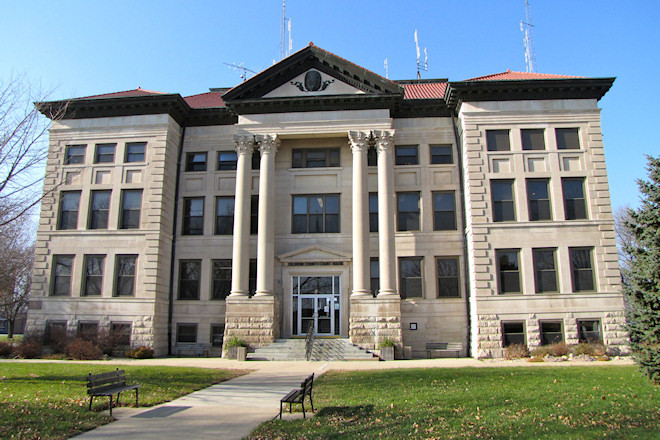On August 9, 1855, Michael Collins, a native of Ireland, moved into a cabin on Section 13 of Lizard Township in Pocahontas County. It was hereon August 15, 1857, that the first Mass was offered by Father John Vahey, a resident priest of Fort Dodge.
In 1870 Fr. M.C. Lenihan took charge and erected St. Patrick's Church on the Lizard, later establishing missions at Fonda, Pomeroy, Pocahontas, and Manson. Fr. Lenihan came to the Halligan home, now occupied by the James Cunningham family, once a month for three years before construction of St. Thomas was started. Father Lenihan was later consecrated as bishop of the Diocese of Cheyenne, Wyoming. It is in his honor that the parish bears the name of his patron, St. Thomas, the Apostle.
St. Thomas Church was the first Catholic Church in Calhoun County. Church property was purchased in 1883 from Mrs. A. Kautz. The first marriage in St. Thomas Church took place on November 9, 1885. On that date Matthew John Foley and Mary Clarke exchanged their wedding vows. Workmen had to sweep the middle aisle for the couple to proceed to the altar because the church had not been completed. In 1890, Father M. C. Daly was appointed the first resident pastor. He served the parish as well as the missions of Barnum and Pomeroy. A residence was built for the pastor and land was purchased for the parish cemetery from Jack Christmas. Father McAuliffe succeeded Fr. Daly in October, 1902. Church records before 1902 were destroyed.
The first baptism of record was that of Agnes Booge, daughter of Francis Booge and Frances Debener on October 26, 1902, by Fr. McAuliffe. The first funeral was that of Anna Lang, wife of Anton Lang, who died on October 21, 1903. The sacrament of confirmation was administered for the first time in St. Thomas by Rt. Rev. Phillip J. Garrigan,the first bishop of Sioux City diocese, on September 20, 1903.
During Fr. McAuliffe's pastorship the rectory was moved, abasement was built under it, a furnace was installed; a sanctuary, sacristy, and belfry were added to the exterior of the church, a choir loft, metal ceilings and stained glass windows were added to the interior of the church.Fr. Bernard O'Reilly followed in July, 1908. On June 20, 1909, Fr. O'Reilly witnessed the first class of record to receive First Communion. There were 21 communicants.
In May of 1919, Fr. Sweeney was appointed pastor. The interior of the rectory was remodeled, a sleeping porch added to the west side of the house, the old board walk north of the church was removed, the old barn was replaced by a cement block garage and a small indebtedness cleared.
Fr. Lynch was chosen pastor of St. Thomas in September, 1922. During his stay the interior of the church was redecorated and Stations of the Cross were erected.Succeeding Fr. Lynch as pastor was Fr. James Greteman. During the nine years of his pastorate, the rectory was refurnished and redecorated both inside and out. An oak floor was laid in the body of the old church and new oak pews installed. The interior of the church was redecorated and the exterior repainted. Fr. Greteman influenced the parishioners to buy U.S. Governments bonds as the start of a building fund.
On May 8, 1945, Fr. O.A. Dentlinger assumed charge of the parish. Improvements made during his pastorate were installation of the Verdin electric bell ringing system, the Angelus Mass bells and funeral toller, a new electric organ, the new pew kneelers throughout the church were fitted with leather, cushions, and a double acoustic confessional was installed. R. Knobbe took charge of St. Thomas in August, 1952. Improvements in the parish included the installation of a furnace in the church, a main altar, a crucifix, communion rail and two side altars. The choir stairway and loft were paneled and carpeted, a baptistery built, and doors, both inside and out were replaced. A new kitchen, bathroom and a 12' x 39' addition were added to the rectory. Property was purchased to the north for future needs.
In August, 1956, Fr. Charles M. Kneip was appointed pastor of St. Thomas. During his pastorate, the present church was built. The Ebersole property was purchased on December 6, 1957. On May 28, 1962, the Langenwalter property was purchased. In April, 1964, plans were made for the new church parish hall and classrooms by the building committee. The church was completed in 1966, with a total seating capacity of 402 people.

